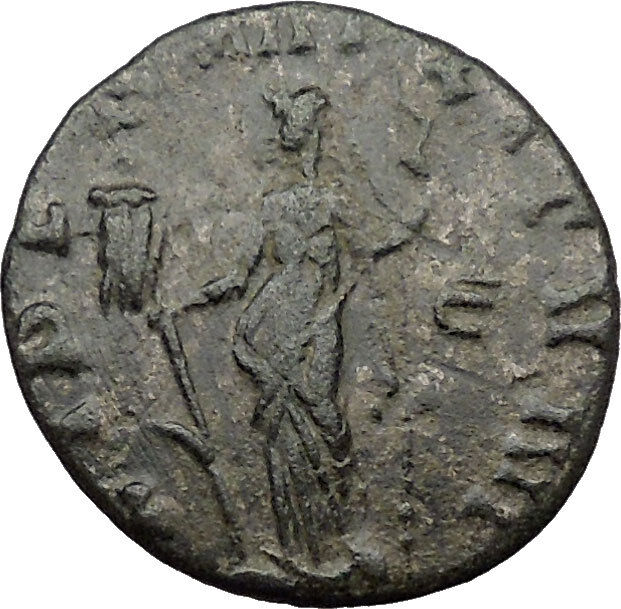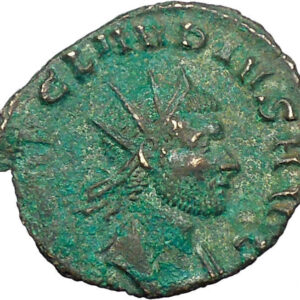|
Constantine II ‘Junior’ – Roman Emperor: 337-340 A.D.
Son of Constantine I ‘The Great’
Bronze Follis / Nummus 20mm (2.89 grams) London (Londinium) mint, struck 321-322 A.D.
Reference: RIC 236
CONSTANTINVS IVN N C, radiate bust left, wearing Imperial mantle.
BEATA TRANQVILLITAS, globe on altar inscribed VOTIS XX in three lines, three stars above; PLON in exergue.
You are bidding on the exact item pictured, provided with a Certificate of Authenticity and Lifetime Guarantee of Authenticity.
Londinium was a settlement established on the current site of the City of London around AD 43. Its bridge over the River Thames turned the city into a road nexus and major port, serving as a major commercial centre in Roman Britain until its abandonment during the 5th century.
Following its foundation in the mid-1st century, early Londinium occupied the relatively small area of 1.4 km2 (0.5 sq mi), roughly equivalent to the size of present-day Hyde Park, with a fortified garrison on one of its hills. In the year 60 or 61, the rebellion of the Iceni under Boudica forced the garrison to abandon the settlement, which was then razed. Following the Iceni’s defeat at the Battle of Watling Street, the city was rebuilt as a planned Roman town and recovered within about a decade. During the later decades of the 1st century, Londinium expanded rapidly and quickly became Great Britain’s largest city. By the turn of the century, Londinium had grown to about 60,000 people and almost certainly replaced Camulodunum (Colchester) as the provincial capital. During the 2nd century, Londinium was at its height. At the time, its forum and basilica were the largest north of the Alps. Emperor Hadrian visited in 122. Excavations have discovered evidence of a major fire which destroyed most of the city shortly thereafter, but the city was again rebuilt. In the second half of the 2nd century, Londinium appears to have shrunk in both size and population.
Although Londinium remained important for the rest of the Roman period, it appears never to have recovered fully from this slump, as archaeologists have found that much of the city after this date was covered in dark earth, which remained undisturbed for centuries. Some time between 190 and 225, the Romans built a defensive wall around the landward side of the city. Along with Hadrian’s Wall and the road network, this wall was one of the largest construction projects carried out in Roman Britain. The London Wall survived for another 1,600 years and broadly continues to define the perimeter of the old City of London.
 Constantine II (Latin: Flavius Claudius Constantinus Augustus; January/February 316 – 340) was Roman Emperor from 337 to 340. Son of Constantine the Great and co-emperor alongside his brothers, his attempt to exert his perceived rights of primogeniture led to his death in a failed invasion of Italy in 340. Constantine II (Latin: Flavius Claudius Constantinus Augustus; January/February 316 – 340) was Roman Emperor from 337 to 340. Son of Constantine the Great and co-emperor alongside his brothers, his attempt to exert his perceived rights of primogeniture led to his death in a failed invasion of Italy in 340.
The eldest son of Constantine the Great and Fausta, after the death of his half-brother Crispus, Constantine II was born in Arles in February 316 and raised as a Christian. On 1 March 317, he was made Caesar. In 323, at the age of seven, he took part in his father’s campaign against the Sarmatians. At age ten, he became commander of Gaul, following the death of Crispus. An inscription dating to 330 records the title of Alamannicus, so it is probable that his generals won a victory over the Alamanni. His military career continued when Constantine I made him field commander during the 332 campaign against the Goths.
Following the death of his father in 337, Constantine II initially became emperor jointly with his brothers Constantius II and Constans, with the Empire divided between them and their cousins, the Caesars Dalmatius and Hannibalianus. This arrangement barely survived Constantine I’s death, as his sons arranged the slaughter of most of the rest of the family by the army. As a result, the three brothers gathered together in Pannonia and there, on 9 September 337, divided the Roman world between themselves. Constantine, proclaimed Augustus by the troops received Gaul, Britannia and Hispania.
He was soon involved in the struggle between factions rupturing the unity of the Christian Church. The Western portion of the Empire, under the influence of the Popes in Rome, favored Catholicism over Arianism, and through their intercession they convinced Constantine to free Athanasius, allowing him to return to Alexandria. This action aggravated Constantius II, who was a committed supporter of Arianism.
Constantine was initially the guardian of his younger brother Constans, whose portion of the empire was Italia, Africa and Illyricum. Constantine soon complained that he had not received the amount of territory that was his due as the eldest son. Annoyed that Constans had received Thrace and Macedonia after the death of Dalmatius, Constantine demanded that Constans hand over the African provinces, to which he agreed in order to maintain a fragile peace. Soon, however, they began quarreling over which parts of the African provinces belonged to Carthage, and thus Constantine, and which belonged to Italy, and therefore Constans.
Further complications arose when Constans came of age and Constantine, who had grown accustomed to dominating his younger brother, would not relinquish the guardianship. In 340 Constantine marched into Italy at the head of his troops. Constans, at that time in Dacia, detached and sent a select and disciplined body of his Illyrian troops, stating that he would follow them in person with the remainder of his forces. Constantine was engaged in military operations and was killed in an ambush outside Aquileia. Constans then took control of his deceased brother’s realm.
|





 Constantine II (Latin: Flavius Claudius Constantinus Augustus; January/February 316 – 340) was Roman Emperor from 337 to 340. Son of Constantine the Great and co-emperor alongside his brothers, his attempt to exert his perceived rights of primogeniture led to his death in a failed invasion of Italy in 340.
Constantine II (Latin: Flavius Claudius Constantinus Augustus; January/February 316 – 340) was Roman Emperor from 337 to 340. Son of Constantine the Great and co-emperor alongside his brothers, his attempt to exert his perceived rights of primogeniture led to his death in a failed invasion of Italy in 340.




